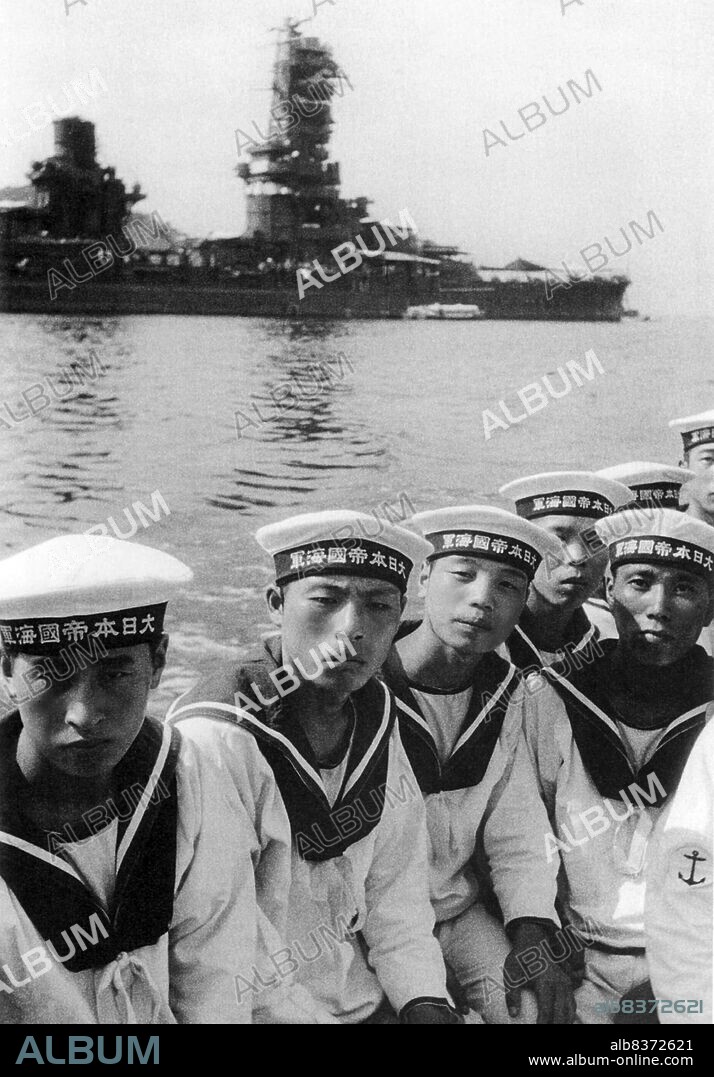alb8372621
Japan: Crew members of the Japanese battleship Fuso moored in the background, Kure, Hiroshima, May 1943

|
Add to another lightbox |
|
Add to another lightbox |



Buy this image.
Select the use:

Title:
Japan: Crew members of the Japanese battleship Fuso moored in the background, Kure, Hiroshima, May 1943
Caption:
Fuso (a classical name for Japan) was the lead ship of the two Fuso-class dreadnought battleships built for the Imperial Japanese Navy. Launched in 1914 and commissioned in 1915, she initially patrolled off the coast of China, playing no part in World War I. In 1923, she assisted survivors of the Great Kanto Earthquake.
. Fuso was modernized in 193035 and again in 193741, with improvements to her armor and machinery and a rebuilt superstructure in the pagoda mast style. With only 14-inch guns, she was outclassed by other Japanese battleships at the beginning of World War II, and played auxiliary roles for most of the war.
. Fuso was part of Vice-Admiral Shoji Nishimura's Southern Force at the Battle of Leyte Gulf. She was sunk in the early hours of 25 October 1944 by torpedoes and naval gunfire during the Battle of Surigao Strait. Some reports claim that Fuso broke in half, and that both halves remained afloat and burning for an hour, but according to survivors' accounts, the ship sank after 40 minutes of flooding. Of the few dozen crewmen who escaped, only 10 survived to return to Japan.
. Fuso was modernized in 193035 and again in 193741, with improvements to her armor and machinery and a rebuilt superstructure in the pagoda mast style. With only 14-inch guns, she was outclassed by other Japanese battleships at the beginning of World War II, and played auxiliary roles for most of the war.
. Fuso was part of Vice-Admiral Shoji Nishimura's Southern Force at the Battle of Leyte Gulf. She was sunk in the early hours of 25 October 1944 by torpedoes and naval gunfire during the Battle of Surigao Strait. Some reports claim that Fuso broke in half, and that both halves remained afloat and burning for an hour, but according to survivors' accounts, the ship sank after 40 minutes of flooding. Of the few dozen crewmen who escaped, only 10 survived to return to Japan.
Credit:
Album / Universal Images Group / Pictures From History
Releases:
Image size:
3489 x 5005 px | 50.0 MB
Print size:
29.5 x 42.4 cm | 11.6 x 16.7 in (300 dpi)
Keywords:
1943 • ARMADA • ARMY: SOLDIER • ASIA • ASIAN • BATTLESHIP • FLEET • FUSO • GUERRA • HIROSHIMA • HUNDRED YEARS WAR • IMPERIAL NAVY • JAPAN • JAPANESE • KURE • MARINE • MILITAR • MILITARS • MILITARY • NAVAL • NAVY • PEOPLE'S ARMY SOLDIER • PHOTOGRAPH • RISING SUN • SAIL • SAILOR • SEA • SEAMAN • SECOND WORLD WAR • SOLDIER SOLDIERS • SOLDIER • SOLDIERS • SOLIDER • TROOPS • VELA • WAR (WORLD WORLD 2) • WAR • WARFARE • WARRIOR • WARRIORS • WARS • WARSHIP • WORLD WAR 2 • WORLD WAR II • WORLD WAR TWO • WW II • WW2 • WWII


 Pinterest
Pinterest Twitter
Twitter Facebook
Facebook Copy link
Copy link Email
Email
